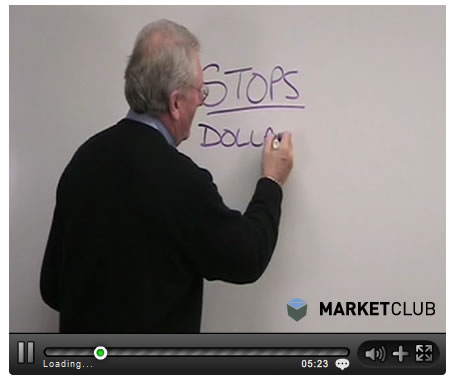Learn to Trade Using Stop Losses to Lock in Profits (Video)
InvestorEducation / Learn to Trade Feb 20, 2009 - 12:38 PM GMTBy: INO
 This little trading tip can and will make a difference in your trading results in 2009.
This little trading tip can and will make a difference in your trading results in 2009.
Stops are enormously important part of a traders arsenal of trading tools. Some traders confirm that stops are the most important part of their trading armour.
So here are three ways to use stops to protect your capital and lock in profits from a trade. These three money management techniques can be used in stock, futures and forex trading.
The important rule is that you do use a real stop in the marketplace. A friend of mine joked with me that that he had never seen a “mental stop” filled electronically or in the pits.
If the market is good your stop will not be hit. If the market is bad or changing direction then you'll want to be out of it anyway. That is why stops are so crucial to trading success.
Here are the three most commonly used types of stops. Which one do you use?
(1) Dollar stop.
(2) Percentage stop.
(3) Chart stop.
If you chose (1) you'd be correct, but, you would also be correct if you had chosen 2 or 3. All three are money management stops and are used to either lock in profits or protect capital.
1) A dollar stop, is when you set a predetermined dollar amount to a trade. Let's say you want to risk $500 on a grain trade or $750 on a stock trade. Once you get your fill back from your broker or electronically online you simply figure from your fill price where to put your stop.
Pros: Easy to implement and use.
Cons: Can place stops too close in a volatile market
————————————————–
2) Percentage stop, is a very simple way for you to place a stop on a position. Here's how it works. Let's say your trading account is 100,000 dollars and let's say you only want to risk 1% of your total portfolio on any one trade. You simply take a $1,000 risk which represents 1% of your over all portfolio. This can help enormously in avoiding taking BIG LOSSES. A 1% loss is easy to absorb. A 30% or 40% loss in a trade is an account killer, and should be avoided at all costs.
Pros: Easy to implement and use.
Cons: Can place stops too close.
————————————————–
3) Chart stop, a chart stop is where you place a stop that is either above or below a crucial chart level. The good thing about a chart stop is that this level is often used by other traders. That can both be a good thing and a bad thing, here's why. Using either one of our first two examples only you know where the stop is. With a chart stop, a great many traders/brokers know that is where the stops are. In an illiquid market this type of stop should not be used, as many times brokers gun for the stops. In a highly liquid and active market this is a good stop to use.
Pros: Very easy to implement and use.
Cons: Can't be used in thinly traded markets.
————————————————–
So there you have it. Now you have all three ways to manage your money and protect your profits in 2009.
Use stops…let them work for you.
Adam Hewison
President, INO.com
Co-creator, MarketClub
By INO.com
INO and Quote Providers furnish quotes and market analysis without responsibility for accuracy and is accepted by the site visitor on the condition that transmission or omissions shall not be made the basis for any claim, demand or cause for action. The information and data was obtained from sources believed to be reliable, but we do not guarantee its accuracy. Neither the information, nor any opinion expressed, constitutes a solicitation of the purchase or sale of any futures or options..
INO Archive |
© 2005-2022 http://www.MarketOracle.co.uk - The Market Oracle is a FREE Daily Financial Markets Analysis & Forecasting online publication.




